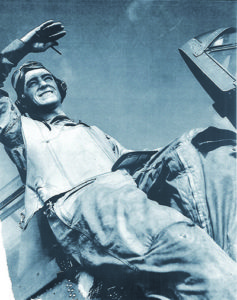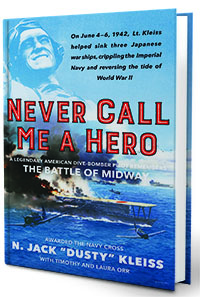
IN JUNE 1942 AT THE PIVOTAL BATTLE OF MIDWAY, Lieutenant Norman Jack Kleiss hit Japanese carriers Kaga and Hiryu and Japanese heavy cruiser Mikuma in dive-bombing attacks. Only Lieutenant Richard “Dick” Best matched the feat of hitting two Japanese carriers in one day and not even Best scored three hits in four total attacks during the battle. Thus, in terms of hits, Kleiss emerged as the single most effective American pilot at Midway. That alone would imprint this book with importance, but the meticulous attention to detail and compelling narration make it soar.
Kleiss’s intensive research of his squadron, Scouting Squadron 6, on the carrier USS Enterprise (CV-6) forms the vivid heart of this work and pays tribute to his comrades, who perished at a dreadful rate in the six months from Pearl Harbor to Midway. His story is en-riched by the letters he exchanged with the beautiful woman who would become his life partner after the battle and by extensive interviews with Kleiss by his coauthors.

The narrative climbs rapidly through sketches of the author’s upbringing in Kansas, his days at Annapolis, early obligatory surface ship service, and his initially star-crossed romance with future wife Eunice Marie “Jean” Mochon. Having earned his pilot wings, Kleiss is assigned to fly a Douglass SBD Dauntless. “Compared to learning to dive bomb, a roller coaster was a ticket to Dullsville,” reports Kleiss. His descriptions of training and combat in that demanding technique are riveting.
Along the way Kleiss explains the comical episode that earned him the nickname “Dusty” (when he landed at a Marine Corps base, his plane kicked up a dust cloud so big it impeded flight operations); provides illuminating facets of Admiral William F. Halsey Jr.’s leadership (one Halsey decision probably saved Kleiss’s life); and describes sympathetically but candidly the internal dynamics and personalities within his squadron and the Enterprise Air Group. Commendably, Kleiss does not overlook the squadron’s enlisted men. Indeed, few aviation memoirs devote as much attention to the men who maintained and serviced a unit’s aircraft. Kleiss portrays several such sailors and particularly offers full honors to John W. Snowden, his faithful and skilled “rear seater.” One poignant recurrent theme is how the squadron adjusted to its tremendous loss rate and absorbed new crews.
Personal accounts of Americans who fought in World War II have flourished in the past two decades just as they pass from the scene. I cannot think of any I would recommend above this work. —Richard B. Frank is a historian of the Asia-Pacific War and a member of the Board of Presidential Counselors of the U.S. National World War II Museum.





